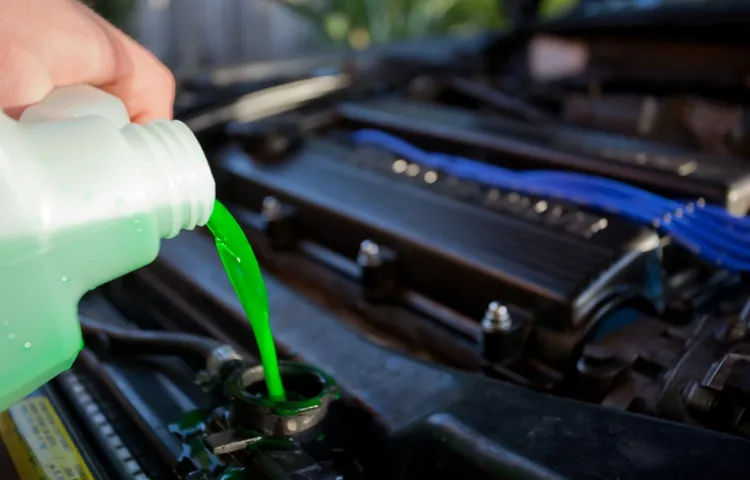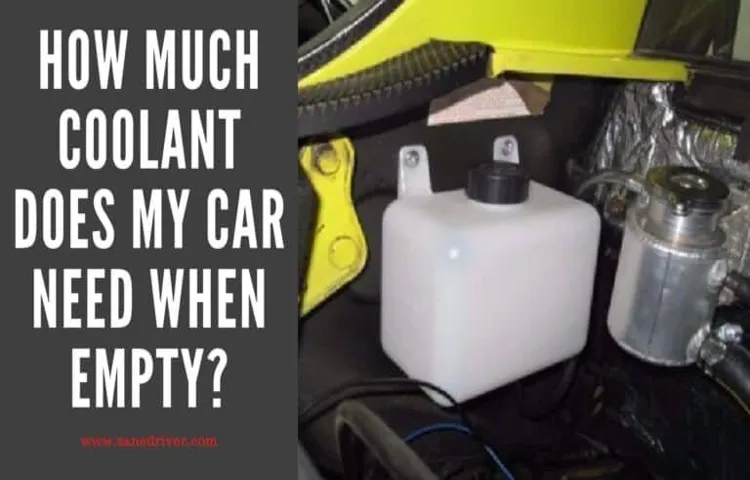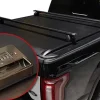Is your car running hotter than usual? Do you notice steam coming from under the hood? These could be signs that your car is in need of coolant. Coolant, also known as antifreeze, is a vital component in keeping your car’s engine temperature regulated and preventing it from overheating. Without proper levels of coolant, your car’s engine could suffer serious damage.
In this blog post, we will discuss the signs that your car needs coolant and the importance of keeping your coolant levels in check. So, grab a cup of coffee and let’s dive in!
Table of Contents
1. Engine Overheating
Are you wondering how to tell if your car needs coolant? One sign that your car may be in need of coolant is if the engine begins to overheat. This can be a serious problem if left untreated and can cause severe damage to your engine. One way to check if your engine is overheating is to look at the temperature gauge on your dashboard.
If it is in the red zone or is higher than normal, it is a clear indication that your engine is getting too hot. Another way to tell if your car needs coolant is if you notice steam or smoke coming from under the hood. This can be a sign that your engine is overheating and needs coolant to bring the temperature down.
It is important to address these signs of overheating as soon as possible to prevent further damage to your car.
Watch for the temperature gauge on your dashboard.
One of the most common problems that drivers can encounter is engine overheating. It’s important to keep an eye on the temperature gauge on your car’s dashboard, as it can help you detect any issues before they become major problems. The temperature gauge is a small but essential tool that gives you an indication of how hot your engine is running.
If the gauge starts to climb into the red zone or if you notice steam coming from under the hood, it’s a clear sign that your engine is overheating. Ignoring an overheating engine could lead to severe damage, such as a blown head gasket or even a cracked engine block. So, if you notice that your temperature gauge is indicating higher-than-normal temperatures, it’s crucial to pull over safely and allow the engine to cool down before continuing your journey.
In some cases, simply checking the coolant level and adding more coolant can resolve the issue. However, if the overheating persists or if you notice any other signs of a problem, it’s best to consult a professional mechanic to diagnose and fix the underlying issue. Taking prompt action when it comes to engine overheating can save you from costly repairs down the line.

Listen for any unusual sounds coming from the engine.
One of the key signs that your engine is overheating is unusual sounds coming from under the hood. When your engine is running normally, it should operate quietly and smoothly. However, if you hear any strange noises, it could be a sign that something is wrong.
So, what exactly should you be listening for? Well, there are several sounds that could indicate engine overheating. For example, you might hear a loud knocking or tapping noise, which could be caused by a lack of lubrication due to overheating. Another sound to be aware of is a hissing or sizzling noise, which could suggest a coolant leak or a problem with the cooling system.
It’s important to pay attention to these sounds and take them seriously, as ignoring them could lead to further damage to your engine. So if you hear any unusual noises coming from your engine, it’s best to have it checked out by a mechanic as soon as possible.
2. Low Coolant Level
Do you know if your car needs coolant? One of the signs to look out for is a low coolant level. Coolant is an essential fluid that helps regulate the temperature of your car’s engine, preventing it from overheating. So, if there isn’t enough coolant in the system, it can lead to serious problems.
One way to check the coolant level is by looking at the coolant reservoir tank. It is usually located near the radiator and has markings indicating the minimum and maximum levels. If the coolant level is below the minimum mark, it’s time to add more coolant.
Another way to tell if your car needs coolant is by paying attention to the temperature gauge on your dashboard. If it starts to rise steadily and reaches the red zone, it could be a sign that your car is low on coolant. Ignoring this warning sign can lead to engine damage and costly repairs.
So, it’s always important to keep an eye on your coolant levels and make sure they are topped up.
Open the hood and check the coolant reservoir.
“low coolant level” When it comes to maintaining your vehicle, it’s important to know what to look for under the hood. One common issue that many car owners face is a low coolant level. Coolant, also known as antifreeze, plays a crucial role in keeping your engine cool and preventing it from overheating.
So, if you notice that the coolant level in your vehicle’s reservoir is low, it’s definitely something you need to address. To check the coolant level, you’ll need to locate the coolant reservoir. This is usually a translucent plastic tank that is connected to the radiator.
It’s important to note that you should only check the coolant level when the engine is cool to avoid any potential burns. Once you’ve opened the hood and found the coolant reservoir, take a look at the markings on the side of the tank. There should be a minimum and maximum line indicating the appropriate coolant level.
If the coolant level is below the minimum line, it’s a clear sign that you need to add more coolant. But why is a low coolant level such a big deal? Well, coolant is responsible for absorbing and dissipating the heat generated by the engine. When the coolant level is low, there is not enough of it to effectively cool down the engine.
This can lead to overheating, which can cause serious damage to your car’s engine and other components. If you find that your coolant level is low, it’s important to add more coolant as soon as possible. Make sure to use the appropriate coolant recommended by your vehicle’s manufacturer.
You can easily purchase coolant at any automotive store or even online. Adding coolant is a simple process. Just make sure the engine is cool, remove the cap from the coolant reservoir, and pour the coolant into the tank.
Inspect the coolant level indicator.
“low coolant level indicator” and “inspect coolant level” Have you ever experienced your engine overheating? It can be a frustrating and potentially dangerous situation. One possible cause of engine overheating is a low coolant level. That’s why it’s essential to regularly inspect the coolant level indicator in your vehicle.
This small device is usually located on the side of the coolant reservoir and can give you a quick and easy way to check if your coolant level is too low. If the indicator shows that the coolant level is below the recommended level, it’s crucial to address the issue promptly. Low coolant levels can lead to insufficient cooling of the engine, resulting in overheating and potential damage.
So, make it a habit to inspect your coolant level indicator regularly and ensure that your coolant levels are always within the appropriate range.
3. Visible Coolant Leaks
Have you ever wondered how to tell if your car needs coolant? One clear sign is visible coolant leaks. If you notice an orange or green fluid dripping from underneath your vehicle, it could be a coolant leak. Coolant, also known as antifreeze, is responsible for regulating your engine’s temperature and preventing it from overheating.
Over time, the hoses or gaskets that contain the coolant can deteriorate, leading to leaks. These leaks can become more apparent when your car is parked or after you’ve driven it for a while. If you spot a puddle of coolant under your car, it’s important to address the issue promptly to prevent further engine damage.
Look for puddles of coolant under the car.
When it comes to diagnosing a potential coolant leak in your car, one of the most obvious signs to look out for is puddles of coolant underneath the vehicle. If you happen to notice a wet spot or a puddle of brightly colored liquid (often green or orange) in the vicinity of your car, it’s a clear indication that there is a leak somewhere in the cooling system. Coolant leaks can occur due to a variety of reasons, such as a damaged radiator, a cracked hose, or a faulty water pump.
The coolant is responsible for regulating the temperature of the engine and preventing it from overheating, so it’s crucial to address any leaks as soon as possible to avoid serious engine damage. If you spot puddles of coolant under your car, it’s best to have a professional mechanic inspect and repair the issue promptly.
Check for any signs of coolant leakage in the engine bay.
When it comes to keeping your engine running smoothly, checking for visible coolant leaks should be at the top of your maintenance checklist. Coolant is essential for preventing your engine from overheating, so any leaks can lead to serious engine damage. To check for coolant leaks, open the hood of your car and take a look at the engine bay.
Look for any signs of wetness or stains around hoses, radiator, or water pump. If you see any coolant dripping or pooling, it’s a clear indication of a leak that needs to be addressed. Just like a leaky faucet, coolant leaks can start small but quickly escalate into a larger problem if left untreated.
So, it’s important to address any visible leaks as soon as possible to prevent further damage to your engine.
Conclusion
So, to summarize our exploration of how to know if your car needs coolant, let me paint you a picture. Imagine you’re driving down the road, feeling all cool and confident. But suddenly, your car starts overheating, smoke starts billowing out from under the hood, and your engine starts making those dreadful clanking sounds.
Talk about a hot mess! Now, let’s rewind a bit and pretend you were a savvy car owner who knew the signs of low coolant. You would have noticed the temperature gauge creeping up into the danger zone, giving you a heads-up that something was amiss. With a quick glance under the hood, you would have noticed that the coolant reservoir was bone dry, a clear indicator that your car was thirsting for coolant like a marathon runner in the Sahara Desert.
So, how do you know if your car needs coolant? Keep an eye on that temperature gauge, listen for any unusual engine noises, and regularly check the coolant reservoir. And remember, a car without coolant is like a person without water – an absolute disaster waiting to happen. So stay cool, stay vigilant, and keep that coolant flowing like the lifeblood of your trusty four-wheeled companion!”
FAQs
How do you know if your car needs coolant?
If your car’s engine temperature gauge is in the red or if you notice steam coming from under the hood, it may be a sign that your car needs coolant. You can also check the coolant reservoir to see if the level is low.
Can I use water instead of coolant in my car?
While you can temporarily use water in an emergency situation, it is best to use a coolant/antifreeze mixture in your car’s cooling system. Coolant is specially formulated to provide better temperature regulation and prevent corrosion.
How often should I check my car’s coolant level?
It is recommended to check your car’s coolant level every time you check your oil or at least once a month. This will help ensure that your car’s cooling system is properly maintained.
What type of coolant should I use in my car?
The type of coolant you should use in your car depends on the make and model. It is best to consult your car’s owner manual or ask a mechanic to determine the correct coolant type for your vehicle.
Can I mix different types of coolant in my car?
It is generally not recommended to mix different types of coolant in your car’s cooling system. Different types of coolant can have different chemical compositions and mixing them can lead to a detrimental effect on your car’s cooling system.
How often should I replace my car’s coolant?
The frequency of coolant replacement varies depending on the make and model of your car. It is typically recommended to replace the coolant every 2-5 years or as specified in your car’s owner manual.
Can a car overheat even if the coolant level is fine?
Yes, a car can overheat even if the coolant level is fine. There could be other issues such as a malfunctioning thermostat, a leaking radiator, or a faulty water pump that can cause the car to overheat. It is best to have a professional mechanic diagnose the problem.



